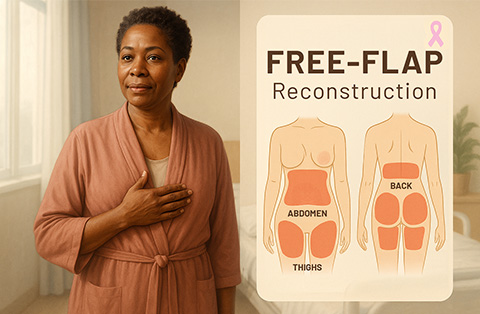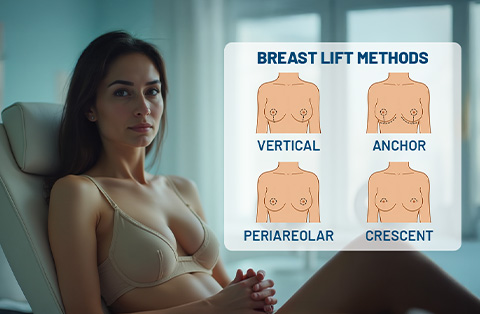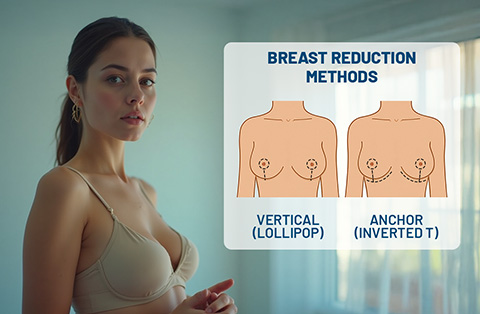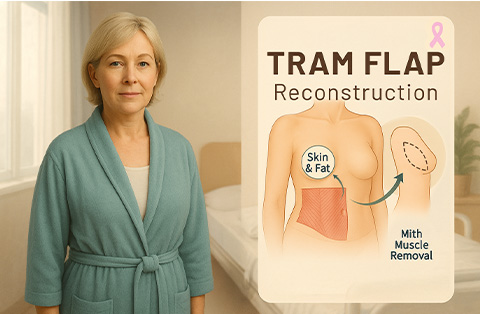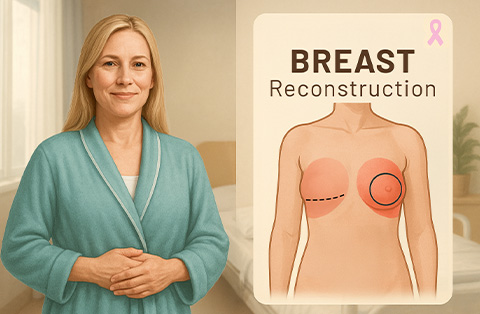Tuberous breasts, a condition often noticeable during puberty, involve abnormal breast development, leading to a unique appearance. This condition, while not harmful to physical health, can significantly impact self-esteem and body image. Understanding tuberous breast deformity is crucial for those considering cosmetic surgery as a means to address this concern.
Understanding Tuberous Breast Syndrome
What is Tuberous Breast Syndrome?
Tuberous Breast Syndrome, also known as tubular breasts, is a developmental condition that affects the shape and growth of the breasts. It typically becomes noticeable during puberty when the breasts should be developing.
This condition is characterized by breasts that are irregularly shaped, often appearing elongated or constricted at the base. Unlike typical breast development, tuberous breasts may not fully develop or may develop unevenly, leading to a range of aesthetic concerns.
Symptoms and Diagnosis
The symptoms of Tuberous Breast Syndrome can vary significantly from person to person but generally include:
- Irregular Shape and Size: Breasts may appear elongated, conical, or ‘tube-like’. The base of the breast is often restricted, leading to a narrow appearance.
- Asymmetry: It’s common for one breast to be more affected than the other, leading to noticeable differences in size and shape between the two breasts.
- Enlarged Areolas: The areolas may appear unusually large and puffy due to herniation of breast tissue.
- Spacing Between Breasts: There’s often a wider-than-normal gap between the breasts.
- Underdevelopment: In some cases, the breasts may not develop significantly, leading to a lack of breast tissue.
Diagnosis of tuberous breast syndrome is typically made through a physical examination by a qualified medical professional, often a plastic surgeon or a breast specialist. In some cases, imaging tests such as mammograms or MRIs may be used to assess the internal structure of the breasts and to aid in planning for potential corrective procedures.
Psychological and Emotional Impact
The psychological and emotional impact of Tuberous Breast Syndrome should not be underestimated. For many, the physical appearance of their breasts is closely tied to their self-esteem and body image. Individuals with tuberous breasts may experience:
- Self-Consciousness: Feelings of embarrassment or self-consciousness, especially in situations like changing rooms or intimate relationships.
- Impact on Social Life: Avoidance of social activities that involve swimwear or more revealing clothing.
- Emotional Distress: Feelings of femininity or normalcy can be affected, leading to emotional distress or anxiety.
- Body Image Issues: Persistent concerns about body image may lead to broader issues with self-esteem and confidence.
Recognizing and addressing these psychological and emotional aspects is a crucial part of the overall management of Tuberous Breast Syndrome. Support from mental health professionals, support groups, or counseling can be beneficial alongside any physical treatments.
It’s important for individuals to understand that these feelings are valid and that options are available to help manage both the physical and emotional aspects of this condition.
Tuberous Breast Classification
Overview of Classification Systems
Tuberous breast classification is essential in determining the most effective treatment approach. This classification is based on the severity and specific characteristics of the deformity. The most commonly used system categorizes tuberous breasts into four types, each reflecting the extent of the deformity and the areas of the breast affected.
Detailed Description of Each Type
- Type I: This type involves the lower medial quadrant of the breast. The base of the breast is constricted, but the constriction is less severe than in other types. The breast may appear slightly elongated with a mild herniation of the areola.
- Type II: In this type, the constriction extends to both the lower medial and lower lateral quadrants of the breast. The breast appears more tubular and narrow, with a more noticeable herniation of the areola and a higher inframammary fold.
- Type III: This type involves all four quadrants of the breast. It is characterized by a severely constricted breast base, significant tubularity, and often a pronounced herniation of the areola. The breast appears very narrow and elongated.
- Type IV: This is the most severe form, where the entire breast is affected. The breast is markedly tubular and constricted, with a significant herniation of the areola. There is often a considerable asymmetry between the two breasts.
Tuberous Breast Classification Chart
| Type | Affected Quadrants | Characteristics | Treatment Approach |
| Type I | Lower medial quadrant | Mild constriction, slight elongation, mild areolar herniation | Breast augmentation to improve shape and symmetry |
| Type II | Lower medial and lateral quadrants | More pronounced tubularity and narrowness, noticeable areolar herniation, higher inframammary fold | Combination of breast augmentation and adjustment of inframammary fold |
| Type III | All four quadrants | Severe constriction, significant tubularity, pronounced areolar herniation | Extensive surgical intervention including augmentation, fold adjustment, and tissue reshaping |
| Type IV | Entire breast | Marked tubularity and constriction, significant areolar herniation, asymmetry | Multi-staged approach with augmentation, tissue expansion, and complex reshaping techniques |
How Classification Influences Treatment Options?
The classification of tuberous breasts plays a critical role in guiding treatment options. Each type requires a tailored approach to achieve the best aesthetic outcome:
- Type I: Treatment may involve breast augmentation with implants to address the mild constriction and improve the overall shape and symmetry of the breasts.
- Type II: A combination of breast augmentation and a procedure to lower the inframammary fold is often necessary. This approach helps to expand the constricted base and create a more natural breast contour.
- Type III: More extensive surgical intervention is required, including breast augmentation, lowering of the inframammary fold, and reshaping of the breast tissue. In some cases, tissue expanders may be used to gradually stretch the skin and breast tissue.
- Type IV: This type often requires a multi-staged approach, combining breast augmentation, tissue expansion, and complex reshaping techniques. The goal is to address the severe constriction and achieve symmetry and a natural breast shape.
Understanding the specific type of tuberous breast deformity is crucial in planning the appropriate surgical strategy. It allows for a more predictable outcome and helps in setting realistic expectations for the patient. Each treatment plan is customized to the individual’s unique anatomy and aesthetic goals, ensuring the best possible results.
Causes of Tuberous Breast Disorder
Genetic Factors
The exact etiology of tuberous breast disorder remains a subject of ongoing research, but genetic factors are believed to play a significant role. While no specific gene has been definitively linked to the condition, it often appears in multiple family members, suggesting a hereditary component.
This genetic predisposition may affect the way breast tissue develops during puberty, leading to the characteristic appearance of tuberous breasts.
Developmental Causes
Tuberous breast disorder is primarily a developmental issue that becomes evident during puberty, a critical period for breast development. The disorder is characterized by abnormal development of the breast tissue and the fibrous ring around the areola.
This abnormal development leads to the constriction at the base of the breast, preventing normal expansion and growth, which results in the tubular shape. Hormonal factors during puberty may influence this abnormal development, although the specific mechanisms are not fully understood.
Myths and Misconceptions
There are several myths and misconceptions surrounding tuberous breast disorder, which can lead to confusion and misinformation. One common myth is that this condition can be corrected or prevented through diet, exercise, or hormonal treatments during adolescence. However, these methods have no impact on the development of tuberous breasts, as the condition is not related to lifestyle or hormonal imbalance but is a congenital deformity.
Another misconception is that tuberous breasts are simply a cosmetic issue and do not require medical attention. While tuberous breasts are not typically associated with health risks, the psychological and emotional impact can be significant. Understanding the condition as a legitimate medical concern is crucial in providing appropriate support and treatment options for those affected.
Lastly, some believe that tuberous breasts can resolve on their own over time or after pregnancy and breastfeeding. However, without surgical intervention, the physical characteristics of tuberous breasts typically remain unchanged. It’s important for individuals with this condition to seek accurate information and consult with qualified medical professionals to explore their treatment options.
Tuberous Breast Correction
What is Tuberous Breast Correction?
Tuberous breast correction is a specialized medical procedure aimed at addressing the unique challenges presented by tuberous breast deformity. This condition, characterized by underdeveloped breasts with a constricted base and often enlarged areolas, requires a tailored approach to achieve a more natural breast appearance.
The correction process focuses on reshaping the breast tissue, resizing the areola, and enhancing overall breast symmetry and aesthetics. The goal is to not only improve the physical appearance but also to boost the patient’s self-esteem and body image.
Non-Surgical vs. Surgical Options
When considering correction options, it’s important to distinguish between non-surgical and surgical approaches:
- Non-Surgical Options: While there are limited non-surgical treatments for tuberous breasts, certain methods like hormonal therapy or external tissue expanders are sometimes explored. These options, however, typically offer minimal improvements and are more about managing the condition rather than correcting it.
- Surgical Options: Surgery is the most effective method for correcting tuberous breasts. The procedures can vary depending on the severity of the condition and the patient’s desired outcome. Common surgical techniques include breast augmentation with implants, tissue reshaping, and mastopexy (breast lift). In more severe cases, a combination of these techniques may be employed.
Latest Advances in Tuberous Breast Correction Techniques
The field of cosmetic breast surgery has seen significant advancements, particularly in the treatment of tuberous breasts. Some of the latest techniques include:
- Customized Implants: The development of more diverse and anatomically shaped implants allows for a more personalized approach to breast augmentation, catering to the unique needs of each patient.
- Fat Grafting: This technique involves transferring fat from another part of the patient’s body to the breast. It’s particularly useful in creating a more natural breast shape and correcting minor deformities without the need for implants.
- 3D Imaging Technology: Advanced imaging techniques enable surgeons and patients to visualize the potential outcomes of the surgery, allowing for better planning and expectation management.
- Refined Surgical Techniques: Ongoing improvements in surgical methods have led to more effective reshaping of the breast tissue and areola, minimizing scarring and enhancing the overall aesthetic result.
These advancements have significantly improved the outcomes of tuberous breast correction, making it possible to achieve more natural-looking results with reduced recovery times and lower risks of complications.
As with any surgical procedure, it’s crucial for patients to consult with experienced and qualified plastic surgeons to discuss the most suitable options for their specific condition.
Tuberous Breast Correction Surgery
Detailed Overview of the Procedure
Tuberous breast correction surgery is a complex procedure tailored to address the unique characteristics of each patient’s condition. The surgery aims to reshape and resize the breasts to achieve a more natural and symmetrical appearance.
The procedure typically involves several key steps:
- Reshaping the Breast Tissue: The surgeon releases the constricted breast tissue to allow for a more natural shape. This involves incisions made around the areola or under the breast, depending on the extent of the constriction.
- Breast Augmentation: In many cases, implants are inserted to provide additional volume and improve the overall shape of the breasts. The type and size of the implants are chosen based on the patient’s anatomy and desired outcome.
- Adjusting the Areola: For patients with enlarged or puffy areolas, a reduction may be performed. This step is crucial for achieving a proportionate look post-surgery.
- Mastopexy (Breast Lift): In cases where there is significant sagging, a breast lift may be necessary. This procedure raises the position of the breasts on the chest wall, enhancing their overall appearance.
Preparing for Surgery
Preparation for tuberous breast correction surgery involves several important steps:
- Medical Evaluation: Patients undergo a thorough medical evaluation, including breast examinations and possibly imaging tests, to determine the best surgical plan.
- Discussing Expectations: It’s vital for patients to discuss their expectations and desired outcomes with their surgeon. This conversation helps in creating a realistic surgical plan.
- Pre-Surgical Instructions: Patients receive detailed instructions on how to prepare for surgery, including guidelines on eating, drinking, and medication adjustments.
- Arranging for Recovery: Patients should plan for their post-surgery recovery, including arranging for help at home and time off work.
What to Expect During Surgery?
The surgery is typically performed under general anesthesia and can take several hours, depending on the complexity of the case. Here’s what patients can expect:
- Anesthesia: Patients are placed under general anesthesia, ensuring they are asleep and comfortable throughout the procedure.
- Incisions: The surgeon makes precise incisions, often around the areola or under the breast fold, to access and correct the breast tissue.
- Reshaping and Augmentation: The surgeon reshapes the breast tissue, releases constrictions, and inserts implants if necessary.
- Closing Incisions: Once the desired shape is achieved, the surgeon carefully closes the incisions to minimize scarring.
- Recovery: After the surgery, patients are taken to a recovery area where they are closely monitored. Most patients can go home the same day or the following day, depending on their recovery progress.
Tuberous breast correction surgery is a transformative procedure that can significantly improve the appearance of the breasts and boost a patient’s self-confidence. It’s important for patients to have a clear understanding of the procedure, preparation, and recovery to ensure the best possible outcomes.
Tuberous Breast Correction Without Implant
Alternative Correction Techniques
While implants are a common solution for tuberous breast correction, there are alternative techniques that can be employed, especially for those who prefer a more natural approach or have concerns about implants. These techniques focus on reshaping the existing breast tissue and enhancing breast size and shape without the use of foreign materials.
- Breast Lift (Mastopexy): This procedure is often suitable for tuberous breast correction, particularly when there is sagging or an elongated breast shape. The breast lift involves removing excess skin and reshaping the breast tissue. The nipple and areola can be repositioned to a more natural location, and the size of the areola can be reduced if necessary.
- Tissue Expansion: In cases where the breast skin is tight and constricted, tissue expanders can be used. These devices are temporarily placed under the breast skin and gradually inflated over time, allowing the skin to stretch and grow. This method can create more space for the natural breast tissue to reshape and expand.
Fat Grafting and Tissue Expansion
Fat grafting, also known as autologous fat transfer, is becoming increasingly popular for tuberous breast correction. This technique involves the following steps:
- Fat Harvesting: Fat is harvested from another area of the patient’s body, typically the abdomen, thighs, or buttocks, using liposuction.
- Fat Processing: The harvested fat is then processed and purified.
- Fat Injection: The processed fat is carefully injected into the breasts in layers, allowing for a gradual increase in breast size and improvement in breast shape.
This method is particularly effective for filling out the lower part of the breast and correcting mild to moderate tuberous deformities. It can also be used in conjunction with other techniques, such as a breast lift, for more comprehensive results.
Suitability and Effectiveness
The suitability of non-implant correction techniques depends on several factors, including the severity of the tuberous deformity, the patient’s breast size and skin quality, and their aesthetic goals. Patients with mild to moderate tuberous breasts and sufficient fat reserves are often good candidates for fat grafting. Those with more pronounced sagging may benefit more from a breast lift.
The effectiveness of these techniques can be quite high, especially when performed by an experienced surgeon. Fat grafting offers a natural look and feel, with the added benefit of contouring the area where the fat was harvested. However, it’s important to have realistic expectations, as the increase in breast size may be limited compared to implants, and there may be a need for additional procedures to achieve the desired outcome.
Patients considering tuberous breast correction without implants should consult with a qualified plastic surgeon to discuss the most appropriate options for their specific condition and to understand the potential outcomes and limitations of each technique.
Post-Surgery: Recovery and Aftercare
Immediate Post-Operative Care
After tuberous breast correction surgery, immediate post-operative care is crucial for a smooth recovery and optimal results. Here’s what patients can typically expect:
- Rest and Monitoring: Immediately following surgery, patients are taken to a recovery area where they are closely monitored as they wake up from anesthesia. Most patients can go home the same day, although some may need to stay overnight for observation.
- Pain Management: Some discomfort and pain are normal after surgery. Patients are usually prescribed pain medication to manage this. It’s important to follow the dosage instructions carefully.
- Support Garments: Patients are often required to wear a special surgical bra or compression garment. This helps to reduce swelling and supports the new breast shape during the healing process.
- Activity Restrictions: Patients are advised to avoid strenuous activities, heavy lifting, and extensive upper body movements for several weeks post-surgery to prevent complications and promote healing.
Long-Term Recovery and Expectations
The long-term recovery process varies from patient to patient, but there are common milestones and expectations:
- Swelling and Bruising: Swelling and bruising are common but should gradually subside over several weeks. The final shape of the breasts will become more apparent as the swelling decreases.
- Follow-up Appointments: Regular follow-up appointments are crucial. These allow the surgeon to monitor the healing process and address any concerns.
- Resuming Activities: Most patients can return to work and light activities within a few weeks, but it may take several months before they can resume all normal activities, including exercise.
- Final Results: It can take several months to a year for the final results to fully develop. Patience is key during this period.
Managing Scars and Aftercare
Scarring is a natural part of the healing process after surgery. Here are some tips for managing scars and ensuring proper aftercare:
- Scar Care: Follow the surgeon’s instructions on caring for your incisions to ensure they heal properly. This may include cleaning the incision sites and applying topical treatments or silicone sheets to minimize scarring.
- Sun Protection: Protect scars from sun exposure, as UV rays can darken them and make them more noticeable. Use a high-SPF sunscreen or cover the area when in the sun.
- Massage: Once the incisions have healed, gentle massage can help soften the scars and improve their appearance.
- Patience and Monitoring: Scars typically fade over time but can take up to a year or more to fully mature. If you have concerns about scarring, discuss them with your surgeon.
Proper aftercare and adherence to the surgeon’s instructions are vital for a successful recovery and achieving the best possible outcomes from tuberous breast correction surgery. Remember, every patient’s journey is unique, and it’s important to give your body the time it needs to heal.
Choosing the Right Surgeon for Tubular Breast Surgery
Qualifications and Experience
Selecting the right surgeon for tubular breast surgery is a critical decision that can significantly impact the outcome of your procedure.
Here are key factors to consider:
- Board Certification: Ensure the surgeon is board-certified in plastic surgery. This certification indicates that the surgeon has undergone rigorous training and examinations in the field of plastic surgery.
- Specialization in Breast Surgery: Look for a surgeon who specializes in breast surgery, particularly in correcting tubular breasts. This specialization ensures that the surgeon is familiar with the unique challenges and techniques involved in this type of procedure.
- Experience: Consider the surgeon’s experience, specifically with tubular breast correction. Ask about the number of similar surgeries they have performed and their success rates.
- Before and After Photos: Request to see before and after photos of previous patients who underwent tubular breast surgery. This can give you a realistic idea of the surgeon’s skill and the potential outcomes of the surgery.
Questions to Ask Your Surgeon
When meeting with potential surgeons, it’s important to ask questions to gauge their expertise and your comfort level with them.
Some essential questions include:
- Can you explain the specific techniques you would use for my surgery?
- What are the risks and potential complications of tubular breast surgery?
- How do you handle complications or unsatisfactory results?
- What can I expect in terms of scarring and recovery?
- Can you provide patient references or testimonials?
- What is your policy on revision surgery if I’m not satisfied with the results?
Finding a Trustworthy and Skilled Surgeon
Finding a trustworthy and skilled surgeon involves thorough research and consultation.
Here are some tips:
- Referrals: Start by asking for referrals from your primary care physician or other healthcare professionals. Personal recommendations from friends or family members who have undergone similar procedures can also be valuable.
- Research Online: Look up potential surgeons online. Check their credentials, read patient reviews, and explore their professional websites for information about their practice and expertise.
- Consultation Appointments: Schedule consultation appointments with a few surgeons. This will give you an opportunity to meet them in person, ask questions, and assess their communication style and professionalism.
- Comfort Level: Choose a surgeon with whom you feel comfortable and who listens to your concerns and goals. A good surgeon should make you feel at ease, explain the procedure in detail, and set realistic expectations.
Remember, the right surgeon for tubular breast surgery should not only have the technical expertise and experience but also a commitment to patient care and satisfaction. Take your time to make an informed decision, as this choice is crucial to achieving the best possible results from your surgery.
Costs and Financing of Tuberous Breast Correction Surgery
Average Costs and Factors Influencing Price
The cost of tuberous breast correction surgery can vary widely based on several factors. These include:
- Geographical Location: The cost of surgery can differ significantly depending on the country or city where the procedure is performed.
- Surgeon’s Expertise: Highly experienced and well-regarded surgeons typically charge more for their services.
- Complexity of the Procedure: The severity of the tuberous breast deformity and the specific techniques required can impact the cost. More complex cases requiring extensive reshaping or multiple procedures may be more expensive.
- Hospital and Anesthesia Fees: The cost of the facility where the surgery is performed and the anesthesia used also contribute to the overall expense.
- Post-Surgery Care: Additional costs may include post-operative garments, medications, and follow-up appointments.
How Much Does Tuberous Breast Correction Cost?
The cost of tuberous breast correction surgery can vary significantly from one country to another. Here’s a comparison of average prices in the USA, UK, and Türkiye:
- United States (USA): In the USA, the average cost of tuberous breast correction surgery can range from $5,000 to $15,000 or more. This wide range is due to the varying degrees of the condition and the different approaches surgeons may take.
- United Kingdom (UK): In the UK, the cost for this surgery typically ranges from £4,000 to £7,000. The National Health Service (NHS) may cover the procedure in some cases, but this is rare and usually only in severe cases with significant psychological impact.
- Türkiye (Turkey): Türkiye has become a popular destination for medical tourism due to its more affordable healthcare. The cost of tuberous breast correction surgery in Türkiye can range from $2,500 to $5,000, significantly lower than in the USA and UK. This affordability, combined with the high standard of medical care, makes Türkiye an attractive option for many.
It’s important to note that while cost is a significant factor, it should not be the only consideration when choosing a surgeon and location for surgery. The surgeon’s experience, the quality of care, and the safety standards of the facility are equally important.
Frequently Asked Questions
Does insurance cover tuberous breast correction?
Insurance coverage for tuberous breast correction varies. In some cases, if the procedure is deemed medically necessary due to psychological or physical health issues, insurance may cover part or all of the costs. It’s important to consult with your insurance provider and obtain a detailed understanding of what is covered under your policy.
Can you breastfeed with tuberous breasts?
Breastfeeding with tuberous breasts is possible, but it can be challenging. Tuberous breasts may have underdeveloped glandular tissue, which can affect milk production. However, many women with this condition are still able to breastfeed, either fully or partially. Consulting with a lactation specialist can provide support and guidance.
Do I have tuberous breasts?
Tuberous breasts are characterized by a constricted breast base, resulting in a more tubular or narrow shape. Other signs include asymmetry, enlarged or puffy areolas, and a wide gap between the breasts. A consultation with a plastic surgeon or a breast specialist can provide a definitive diagnosis.
How common are tuberous breasts?
Tuberous breasts are relatively common, though the exact prevalence is hard to determine as many cases may go unreported or undiagnosed. It’s a condition that typically becomes apparent during puberty and can affect one or both breasts.
What causes tuberous breasts?
The exact cause of tuberous breasts is not fully understood, but it is believed to be a congenital condition with a possible genetic link. It manifests during breast development in puberty, leading to the characteristic appearance. Hormonal factors may also play a role, but lifestyle or environmental factors have not been definitively linked to the development of this condition.
Conclusion
Summary of Key Points
Tuberous breast correction is a transformative journey for individuals dealing with the unique challenges of tuberous breast deformity. This condition, characterized by underdeveloped, asymmetrical breasts with a constricted base, can significantly impact both physical appearance and emotional well-being. Understanding the nature of tuberous breasts, including their classification, causes, and the available correction options, is crucial for anyone considering treatment.
Surgical correction remains the most effective approach, offering various techniques tailored to individual needs, from implants and tissue reshaping to fat grafting. The choice between surgical and non-surgical options should be made after careful consideration of the patient’s specific condition and desired outcomes. The cost of the procedure varies depending on several factors, including geographical location and the complexity of the surgery, and in some cases, insurance may cover part of the treatment.
Consultation and Further Inquiry
Ready to embrace a new chapter in your journey? Contact us today to explore your tuberous breast correction options and take the first step towards a more confident you!


